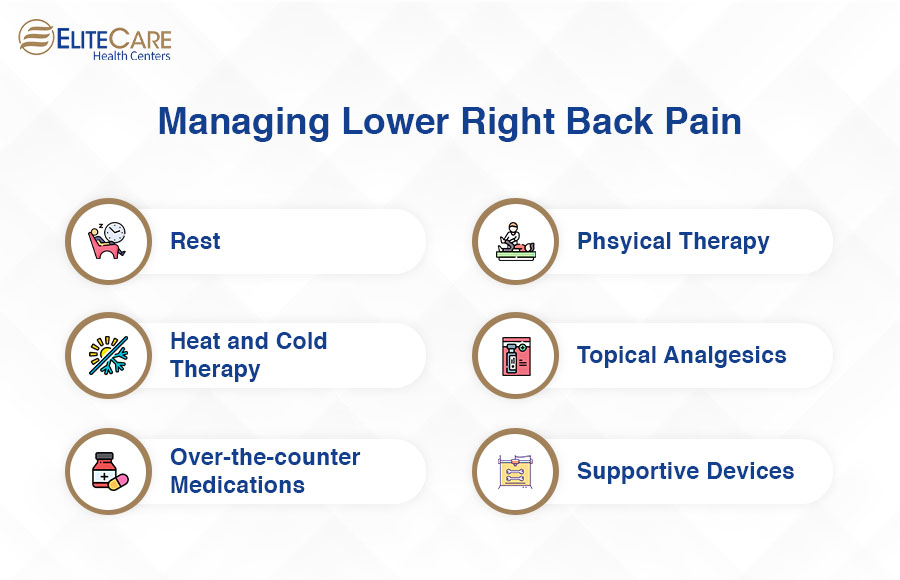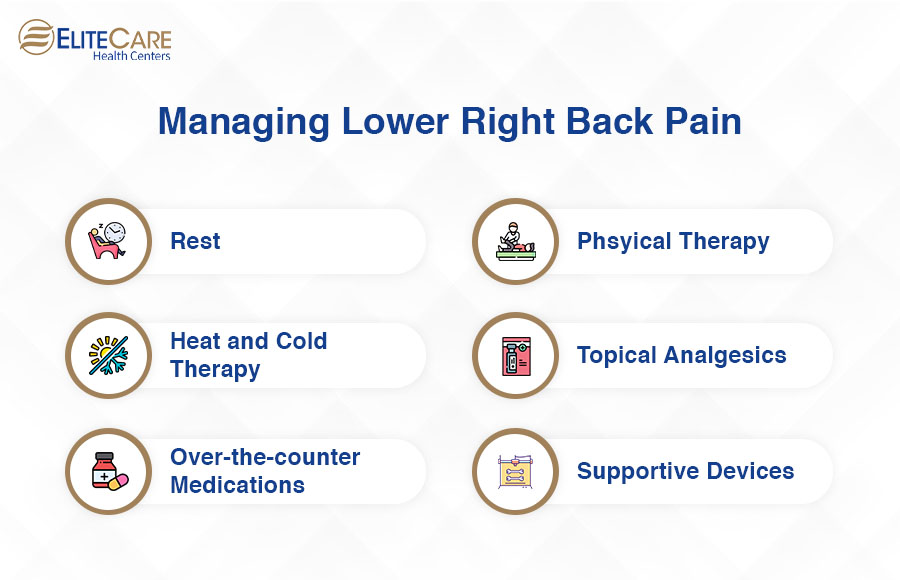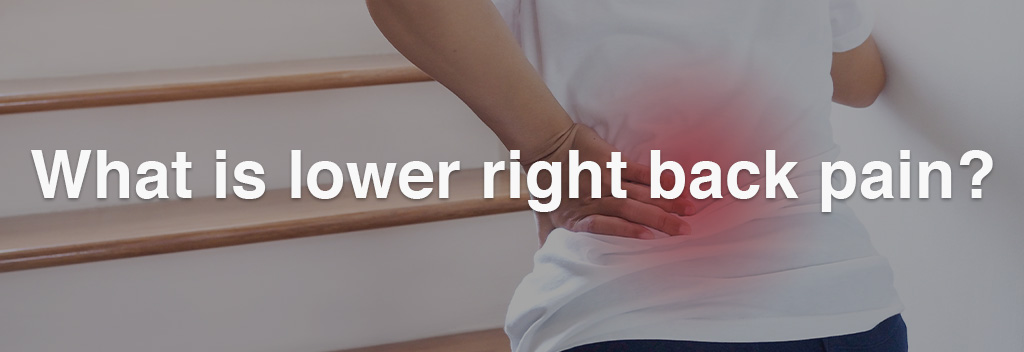
Lower right back discomfort is a prevalent condition that affects people of all ages and from all walks of life. It can range from a subtle, chronic aching to sharp, intense pain, interfering with everyday activities and general quality of life.
It could be caused by a variety of problems ranging from muscle strain caused by activity to diseases of the organs, mid-back, or pelvic region.
Anatomy of the Lower Right Back
Understanding lower right back discomfort requires a basic understanding of the region’s anatomy. The lumbar spine, sacrum, and right side of the pelvis are all part of the lower right back. The lumbar spine comprises five vertebrae (L1 to L5) that support the upper body and allow for movement. The sacroiliac joint is formed by the sacrum, a triangular bone at the base of the spine that attaches to the pelvis. This region’s muscles, ligaments, and nerves are critical in maintaining stability and aiding movement.
Common Causes of Lower Right Back Pain:

1. Muscle Strain
Lower back pain is frequently caused by muscle strain as a result of overexertion, repetitive movements, or poor lifting techniques. Lower back muscles and ligaments can become strained, resulting in pain, stiffness, and discomfort.
Muscle recovery requires ample rest. Applying cold or heat to the affected area, as well as using over-the-counter pain medicines along with gentle stretching exercises can help ease symptoms.
2. Herniated Disc
When the soft inner material of a spinal disc protrudes through the robust outer layer, this is referred to as a herniated or slipped disc. This can irritate neighboring nerves, resulting in discomfort, numbness, or tingling.
Rest, physical therapy, and pain medications are examples of cautious methods. In severe circumstances, surgical intervention to correct the disc condition may be considered.
3. Sciatica
Sciatica is a kind of lower back pain caused by sciatic nerve compression or inflammation. This big nerve, which travels down the back of each leg, can cause acute, shooting pain that extends from the lower back to the legs when triggered. Physical therapy, pain medicines, and, in certain circumstances, surgical intervention are utilized to reduce sciatic nerve pressure.
4. Sacroiliac Joint Dysfunction:
The sacrum is joined to the pelvis by the sacroiliac joint. Lower back pain can be caused by joint dysfunction, especially when walking or standing for lengthy periods.
Physical therapy, medicines, and injections are used to relieve inflammation and pain caused by sacroiliac joint dysfunction.
5. Spinal stenosis
Spinal stenosis is a narrowing of the spinal canal that can cause nerve pressure and lower back pain. This disorder is frequently connected with aging and spinal degeneration.
Treatment usually consists of conservative treatments such as over-the-counter medicines and physical therapy. Surgery may be recommended in rare cases to relieve any strain on the spinal nerves.
6. Osteoarthritis
The degradation of cartilage in joints, especially those in the spine, is known as osteoarthritis or just arthritis. As the cartilage degrades, bones tend to rub against each other, resulting in pain, stiffness, and decreased range of motion.
Medication, physical therapy, and lifestyle changes are used to ease symptoms and enhance joint function.
Diagnosing Lower Right Back Pain
Accurate diagnosis is crucial for effective treatment. Healthcare professionals may use a combination of the following methods:
1. Medical History and Physical Examination:
- Gathering information about the patient’s symptoms, lifestyle, and any recent injuries.
- Conducting a physical examination to assess posture, range of motion, and areas of tenderness.
2. Imaging Studies:
- X-rays, MRI, or CT scans to visualize the bones, discs, and soft tissues in the lower right back.
- Identifying abnormalities such as herniated discs, arthritis, or structural issues.
3. Laboratory Tests:
- Blood or urine tests to check for signs of infection, inflammation, or other systemic conditions.
4. Diagnostic Injections:
- Injecting a local anesthetic or anti-inflammatory medication into specific structures to determine if they are the source of pain.
Managing Lower Right Back Pain:

1. Rest
Allowing the affected area to rest is one of the first measures in treating lower right back pain. Modifying activities that aggravate the discomfort, avoiding heavy lifting, and taking breaks from lengthy periods of sitting or standing may all be part of this.
While rest is necessary for healing, total immobilization is generally discouraged. Gentle movements and stretches may be helpful in the prevention of stiffness.
2. Heat and Cold Therapy
Heat or ice applied to the lower right back can give pain relief and reduce inflammation. Heat treatment, such as using a heating pad or a warm compress, helps in muscle relaxation and blood flow improvement. Cold therapy, such as an ice pack or cold compress, can numb the area and minimize swelling. For some people, alternating between heat and cold applications may be beneficial.
3. Over-the-counter Medications
Nonsteroidal anti-inflammatory drugs (NSAIDs) such as ibuprofen or acetaminophen can help manage pain and reduce inflammation linked with lower right back pain. It’s critical to stick to the suggested amounts and check with a primary care doctor, especially if you have any underlying health issues.
4. Physical Therapy
Physical therapy is essential in the treatment of lower right back discomfort. A physical therapist can create a personalized training program to help you strengthen your core muscles, improve your flexibility, and enhance your posture.
Massage and joint mobilization are examples of therapeutic procedures that can be used to relieve pain and promote healing.
5. Topical Analgesics
Topical analgesic creams, patches, or ointments can be administered directly to the skin across the lower right back. These products can provide localized pain relief and are especially beneficial for people who prefer not to take oral drugs or have specific allergies.
6. Supportive Devices
Lumbar cushions or braces, for example, can provide additional support to the lower right back and promote appropriate alignment. These devices are especially effective for tasks that can strain the back, such as sitting for long periods or performing manual labor.
Preventing Lower Right Back Pain
- Regular exercise to strengthen core muscles and improve flexibility.
- Maintaining a healthy weight reduces strain on the lower back.
- Lifting objects using the legs and not the back.
- Maintaining good posture, especially when sitting for extended periods.
- Using supportive chairs and desks to promote a neutral spine position.
- Taking breaks and incorporating stretching into sedentary activities.
When to Seek Medical Attention?
While mild lower right back pain may resolve with self-care, certain signs and symptoms warrant prompt medical attention. Keep track of progressive pain that is worsening despite conservative measures.
Loss of sensation or strength in the legs, which may indicate nerve compression, is an important indicator to seek medical attention.
Lower right back discomfort is a complex problem with several possible causes, ranging from muscular strain to significant medical disorders. Understanding the underlying causes and receiving medical attention as soon as possible is essential for optimal management.
EliteCare HC, one of the best medical clinics in Florida, offers personalized health and wellness advice. Visit our website or call +1 888-596-2090 for an appointment.
Frequently Asked Questions
A pulled muscle or other back injury is often the source of pain on the right side of the lower back. It could also be caused by an underlying ailment, such as nerve compression in your spine.
If the pain in your back is sore, tight, swollen, and/or bruised, it is most likely muscular rather than organ-related.
Seeing a doctor is advised if lower back discomfort persists or worsens after a few days, if there is a sudden onset of severe pain, or if it happens in conjunction with other troubling symptoms.





